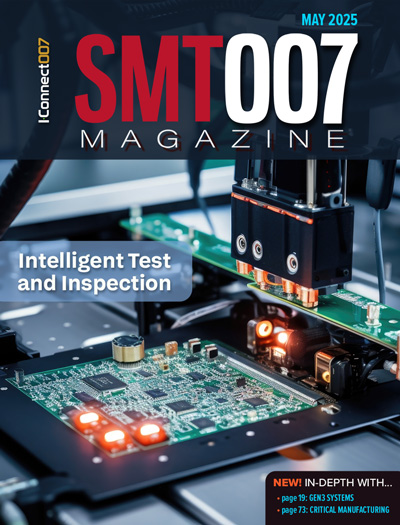-

- News
- Books
Featured Books
- smt007 Magazine
Latest Issues
Current Issue
What's Your Sweet Spot?
Are you in a niche that’s growing or shrinking? Is it time to reassess and refocus? We spotlight companies thriving by redefining or reinforcing their niche. What are their insights?

Moving Forward With Confidence
In this issue, we focus on sales and quoting, workforce training, new IPC leadership in the U.S. and Canada, the effects of tariffs, CFX standards, and much more—all designed to provide perspective as you move through the cloud bank of today's shifting economic market.

Intelligent Test and Inspection
Are you ready to explore the cutting-edge advancements shaping the electronics manufacturing industry? The May 2025 issue of SMT007 Magazine is packed with insights, innovations, and expert perspectives that you won’t want to miss.
- Articles
- Columns
- Links
- Media kit
||| MENU - smt007 Magazine
Estimated reading time: 6 minutes
SMT Prospects and Perspectives: AI—A Prelude to Opportunities, Challenges and Possibilities
It seems that artificial intelligence (AI) has become unprecedently widespread, an everyday word used by everyone. However, its reality and potential are yet to evolve. On one hand, there is sheer excitement about evolving intellectual and dexterous capabilities to improve our lives, businesses, economy, and national security; on the other, there has been trepidation about unknown and/or unintended consequences.
The explosive offerings of new AI tools and platforms are remaking our daily lives and every aspect of our workplaces, including research, engineering, design, manufacturing, operational management, and technology deployment. The ability to balance between AI’s omnipotent power and its downsides is key to leveraging AI as a virtuous tool. Operations across all sectors, industry, government, and academia alike, will distinguish themselves by how well they use the tools and how reliable and safe the respective tools can deliver.
Since November 2022, the release of ChatGPT and Generative AI (conversational AI), particularly GPT-4 large language model (released March 14, 2023), has been making the development of AI-related products, use cases, and a possible future more crucial to advancing electronics and microelectronics industry into the all-encompassing Industry 4.0—in turn, furthering the well-being of human life.
With that backdrop, I plan to write a series of columns on artificial intelligence, addressing technologies, substantive historical events, state of the art, and potential case-cases, areas of attention, approaches, and human-ingenuity vs. machine intelligence.
AI Perspectives and Visions
In the broad sense of AI, it is intriguing to see that the widely diverse and disparate perspectives of and visions for AI are as wide as the Grand Canyon. To name a few:
- “A little bit scared of technology such as OpenAI’s ChatGPT—concerned about potential disinformation and authoritarian control of AI… the goal is to forge a new world order in which machines free people to pursue more creative work.” —OpenAI CEO, Sam Altman
- “AI—the first word is right, not the second word… not intelligence, not have feelings, emotions, love… We call it intelligence, but we really do not know how the brain works... replacing humans will not happen… All things are to help humans… Can solve individual problems, humans will always be in control… Only one way to produce brain—it takes nine months.” —Steve Wozniak (“The engineer of engineers,” Feb. 9, 2023, CNBC)
- “This is a pivotal moment in AI development… We should carefully consider the consequences. Might they include the potential to wipe out humanity? It is not inconceivable, that is all I’ll say.” —Geoffrey Hinton (Godfather of AI)
- “OpenAI’s GPT model is the most revolutionary advance in technology since internet, cellphones, computers.” —Bill Gates
- “Dreams are kind of like generative artificial intelligence.” —James Cameron, Oscar-winning innovative filmmaker
- “AI has a nonzero chance of annihilating humanity.” —Elon Musk
AI Technology
To map out AI technology from manifold perspectives on the current and future of AI development and deployment, the foundational components behind the AI technology, in a pragmatic sense, include machine learning (ML), deep learning (DL), neural network (NN), Internet of Things (IoT), digital twins, predictive modeling, ChatGPT-led AI boom (Generative AI), and AI with justified confidence and trustworthiness.
Each component stands on its own in terms of technological advancement, yet the useful fruition requires intricate and robust interplay among all components. Understanding and applying that interplay of all relevant components requires both broad-based knowledge and specialized expertise of the respective field.
AI: Present and Future
The future of AI is a global race. As Vladimar Putin said, “Whoever becomes the leader in AI technology will be the ruler of the world.”
Myriad new vistas to capitalize on the sound benefits of AI are emerging and burgeoning. Among many use-cases or potential use-cases, one timely frontier related to our industry is expected to propel Industry 4.0 by leveraging AI/ML/DL/NN, in conjunction with ancillary technologies, to drive into seamlessly autonomous, intelligent cyber-physical systems effectively and reliably. To put a business case forward, the advancement of Industry 4.0:
- Leads to the true materialization of “smart factory.”
- Shall be smart enough and consistently resilient to deliver intended efficiency and effectiveness to be globally competitive carrying a leading edge.
Take another example on national defense and security, where AI will continue to play a heightened role in the efficiency and relevancy of military operations. In large-scale missions, the speed at which data and knowledge cascade is critical to the mission’s success. Holistic command and control are yet to be developed. However, for unmanned aerial vehicles (UAV) or drones, AI enables real-time access to data, which offers preemptive decision-making and simplified command and control; swarms of drones will aid each other by overcoming jamming ploys.
While generative AI adds another dimension to semiconductor design and fabrication, chips are true differentiators to the capabilities and performance of making generative AI models in training and playing a mission-critical role in AI technology deployment. In sync with the CHIPS Act, the semiconductor could be catapulted by generative AI to a potentially phenomenal magnitude, which will create some intense dynamics.
Considering the unparalleled velocity of AI development to harvest the tangible benefits from academia, national laboratories, and industry in a timely manner, the transitioning of scientific research and technology to real-world end-uses calls for an approach that is both creative and bold.
AI Talents
It’s vital to fill key roles in AI development yet demand currently exceeds supply. We must embrace AI technology and stay in the core knowledge zone to nurture the proficient and competitive engineering workforce. The broad-based general knowledge of AI technology offers a consequential opportunity to our industry.
To this end, I have developed a professional development course, “AI—Opportunities, Challenges, and Possibilities,” with the goal of disseminating AI technology to the workforce and provide continuing education to the workforce of our industry. This short course will debut at SMTA International Conference & Exhibition on Oct. 9, offering holistic coverage of AI in its systematic hierarchy with high-level overviews, as well as specific component technologies/techniques and use-cases. The course topics include:
- Background and diverse perspectives on AI
- Current state of AI
- Justified confidence in AI
- Machine learning, deep learning, neural network, digital twin, IoT, and use cases for
- Generative AI, Edge AI, OpenAI—ChatGPT, ChatGPT-4
- How transformers work and diffusion model
- Scientific machine learning and examples in industry applications
- Use cases for modeling/simulation, and digital twin
- Deep learning NN architectures and expressive programming frameworks
- AI’s uncertainty quantification
- New technologies: SNN, dynamic reasoning, continual learning (multitasking)
- Examples of global leaders and competitiveness
- Artificial general intelligence
- Brain, mind, and intelligence
- Future of AI
Concluding thoughts
The objectives of the course are to build and to stay in the knowledge zone; to spur innovative ideas and inspire new vistas for new opportunities; to highlight what it takes to achieve AI with justified confidence/trust; to balance between AI’s power and downsides; and to leverage AI as a virtuous tool to facilitate individual on-the-job efficiency and effectiveness, and enterprise business growth.
Resources
- “The Fourth Industrial Revolution (Industry 4.0): Intelligent Manufacturing,” by Jennie Hwang, SMT007 Magazine, July 2016.
- “Artificial Intelligence: Super-Exciting, Ultra-Competitive,” by Jennie Hwang, SMT007 Magazine, September 2018.
- “Smart Factory Implementation: How Smart Is Smart Enough?” by Jennie Hwang, SMT007 Magazine, April 2020.
Appearances
Dr. Jennie Hwang and Dr. George Karniadakis of Brown University/MIT will instruct a Professional Development Course titled “Artificial Intelligence—Opportunities, Challenges and Possibilities,” Oct. 2, International Symposium on Microelectronics (IMAPS), in San Diego, and on Oct. 9, at SMTA International, Minneapolis. Dr. Hwang also will instruct a course titled “High Reliability—Role of Intermetallic Compound and Tin Whisker,” Oct. 2, and a course on “Solder Joint Reliability—Principle and Practice” on Oct. 10.
This column originally appeared in the October 2023 issue of SMT007 Magazine.
More Columns from SMT Perspectives and Prospects
SMT Perspectives and Prospects: Artificial Intelligence, Part 5: Brain, Mind, IntelligenceSMT Perspectives and Prospects: Artificial Intelligence, Part 4—Prompt Engineering
SMT Perspectives and Prospects: The AI Era, Part 3: LLMs, SLMs, and Foundation Models
SMT Perspectives and Prospects: A Dose of Wisdom
SMT Prospects and Perspectives: AI Opportunities, Challenges, and Possibilities, Part 1
SMT Perspectives and Prospects: Critical Materials—A Compelling Case, Part 3
SMT Perspectives and Prospects: Pearls of Wisdom
SMT Perspectives and Prospects: The Role of Bismuth (Bi) in Electronics, Part 7: A Case Study in Fillet-Lifting


